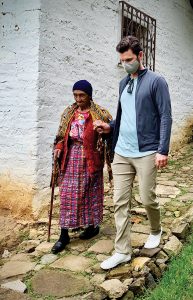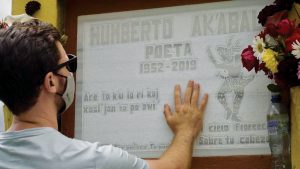By Jake Runestad, composer, USA
Creating music informed and inspired by writers outside of my own culture is like weaving an ornate garment with multicolored threads — each strand contains a complex history of its own, and these threads must be thoughtfully and carefully united into a single tapestry. This weaving of text and music teaches me about new people and places, it challenges me to consider alternate perspectives and it fosters greater compassion for others.

Several years ago, I received a commission from Kantorei, a fantastic choir based in Denver, USA. Kantoreihas a beautiful friendship with the Guatemalan choir Vocalis, and they wished to commission a new piece of music to unite the two choirs and cultures: music from the USA and poetry from Guatemala. After much research, we chose the Mayan poet Humberto Ak’abal (1952-2019) as the poetic voice from Guatemala. Ak’abal’s powerful poems speak of the terror of genocide against the indigenous population, the beauty and importance of the earth, and the role of art in the face of difficulty. El Último Hilo (“The Last Thread”), the resulting musical work scored for SATB choir, string quartet, and marimba (the national instrument of Guatemala), sets Ak’abal’s poems in both K’iche’ (a Mayan dialect) and Spanish. But before I began composing (and because I am not a native speaker of these languages), I had some work to do.
I was born and raised in the USA as a native English speaker and was fortunate to learn Spanish as a second language in my schooling. I have spent significant time in Spanish-speaking countries (Peru, Colombia, Argentina, Costa Rica, Spain, and Guatemala) and while I consider myself fluent in Spanish, it does not feel native in myself. Speaking another language natively requires engaging in the persona of that language, complete with cultural nuances, dialects, slang, and years of immersion. Composing vocal works with English texts feels very natural to me, but other languages require a different approach.
When creating a piece of music with words, composers must be fully informed about the author and text beforewriting a single note. When the composer has a clear idea of the who, what, where, when, why, and how of the text, they are more prepared to illuminate the words with intention and authenticity. Setting poetry that is not in the composer’s native language introduces another layer of challenges. My approach to this process includes four steps:
1. Research
When preparing to set a text to music, the composer must study the historical context behind the author and their words. Some questions I ask myself include: When and where did the author live? What was going on in the world/their community at that time? How did that time and place impact the author’s work? How and why did the author write the words (scratched on the wall of a death camp in WWII Germany, penned in a personal journal, a love letter, etc.)? What cultural nuances and metaphors are embedded in the text? For example: the quetzal is the national bird of Guatemala, but it is also the monetary unit. If I assumed the author was talking about the bird, I would be in trouble if the poem was actually talking about money! This is where consulting with a native speaker is crucial in uncovering as much meaning as possible.
2. Immerse & Absorb
To have a clearer understanding of the author’s life and language, I immerse myself in a wide breadth of their creative output, in music from their culture, in works of other artists from their culture, and in the place they live(d) (whether physically or through forms of visual media). When I am setting a language other than English, I seek out recordings of native speakers and singers and listen for hours to become familiar with the language’s sounds and rhythms. The more I can ingest of the author’s sonic and visual world, the more clearly my music will communicate the nuance of the author’s intent.
3. Embody
No matter the language of the text, I must be comfortable speaking and singing it in an idiomatic manner. If the language is not my native tongue, I work with a native speaker so I can learn the correct pronunciations, prosody/rhythms, and nuances of phrase shape. It is my job to internalize these words and to be able to express them correctly.
4. Create
Once I feel comfortable with the previous steps, I am prepared to begin creating music. This process involves improvising and singing the words within their cultural and emotional context to uncover the innate musical lines in each phrase (this authentic singing/physicalization is crucial). The instrumentation, musical material, form, and all aspects of the work are informed by the prior three steps.

For El Último Hilo, I learned as much as I could about Guatemala and its history, I spoke with Guatemalans to gain their perspective, I listened to hours of diverse genres of music sung in Spanish, and I worked with native speakers of both K’iche’ and Spanish. A friend of Humberto’s recorded the K’iche’ for me and I practiced diligently until I could mimic every sound, rhythm, and phrase. I worked with professional singers (and language gurus) to create IPA notation for the K’iche’ and included this in the score. I also had the honor of visiting Humberto’s home and writing studio, communing with his mother, sister, and widow, and visiting his grave (the power of this visit is worthy of its own article).
Creating this work was a transformational experience for me and all of those involved. El Último Hilo has beauty, power, and depth because of Humberto’s words, and also because of the great care we took in engaging with the context surrounding his poems and history. Weaving together text, music, culture, and story in an informed and intentional manner deepens our musical experiences and enriches the communicative power of our art form, resulting in a beautiful tapestry of community and empathy.
 Considered “one of the best of the younger American composers” (Chicago Tribune), EMMY®-winning and GRAMMY®-nominated composer and conductor Jake Runestad has received commissions and performances from leading ensembles and organizations such as Voces8, Washington National Opera, the Philippine Madrigal Singers, the Netherlands Radio Choir, the Swedish Radio Symphony Orchestra, the Dallas Symphony Chorus & Orchestra, the Pacific Chorale & Symphony, the Santa Fe Desert Chorale, and a GRAMMY®-nominated all-Runestad album from Conspirare called “The Hope of Loving.” In 2019, Jake became one of the youngest composers ever awarded the prestigious Raymond C. Brock commission by the American Choral Directors Association. Dubbed a “choral rockstar” by American Public Media, Jake is one of the most frequently performed composers in the world and has traveled to conduct and clinic ensembles on all but one continent. Jake Runestad holds a Master’s degree in composition from the Peabody Conservatory of the Johns Hopkins University where he studied with Pulitzer Prize-winning composer Kevin Puts. More at: JakeRunestad.com
Considered “one of the best of the younger American composers” (Chicago Tribune), EMMY®-winning and GRAMMY®-nominated composer and conductor Jake Runestad has received commissions and performances from leading ensembles and organizations such as Voces8, Washington National Opera, the Philippine Madrigal Singers, the Netherlands Radio Choir, the Swedish Radio Symphony Orchestra, the Dallas Symphony Chorus & Orchestra, the Pacific Chorale & Symphony, the Santa Fe Desert Chorale, and a GRAMMY®-nominated all-Runestad album from Conspirare called “The Hope of Loving.” In 2019, Jake became one of the youngest composers ever awarded the prestigious Raymond C. Brock commission by the American Choral Directors Association. Dubbed a “choral rockstar” by American Public Media, Jake is one of the most frequently performed composers in the world and has traveled to conduct and clinic ensembles on all but one continent. Jake Runestad holds a Master’s degree in composition from the Peabody Conservatory of the Johns Hopkins University where he studied with Pulitzer Prize-winning composer Kevin Puts. More at: JakeRunestad.com
Edited by Gillian Forlivesi Heywood, Italy/UK

